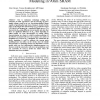Free Online Productivity Tools
i2Speak
i2Symbol
i2OCR
iTex2Img
iWeb2Print
iWeb2Shot
i2Type
iPdf2Split
iPdf2Merge
i2Bopomofo
i2Arabic
i2Style
i2Image
i2PDF
iLatex2Rtf
Sci2ools
ISCAS
2007
IEEE
2007
IEEE
Critical Charge Characterization for Soft Error Rate Modeling in 90nm SRAM
— Due to continuous technology scaling, the reduction of nodal capacitances and the lowering of power supply voltages result in an ever decreasing minimal charge capable of upsetting the logic state of memory circuits. In this paper we investigate the critical charge (Qcrit) required to upset a 6T SRAM cell designed in a commercial 90nm process. We characterize Qcrit using different current models and show that there are significant differences in Qcrit values depending on which models are used. Discrepancies in critical charge characterization are shown to result in under-predictions of the SRAM’s associated soft error rate as large as two orders of magnitude. For accurate Qcrit calculation, it is critical that 3D device simulation is used to calibrate the current pulse modeling heavy ion strikes on the circuit, since the stimuli characteristics are technology feature size dependant. Current models with very fast characteristic timing parameters are shown to result in conservative...
| Added | 04 Jun 2010 |
| Updated | 04 Jun 2010 |
| Type | Conference |
| Year | 2007 |
| Where | ISCAS |
| Authors | Riaz Naseer, Younes Boulghassoul, Jeff Draper, Sandeepan DasGupta, Art Witulski |
Comments (0)

